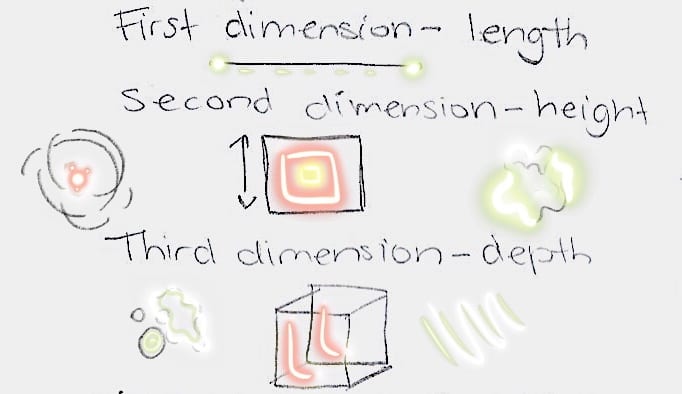Hello friends! Today I am back with another weekly blog challenge post. It’s already week six (whaaaat)! This time it’s all about science. We are required to choose a scientific topic that interests us and write a little something about it. I love science, so sounds good to me! Comment down below what your favourite science subject is!
For my topic, I chose string theory. This is part of physics, and let me tell you, it’s not easy to understand at all. String theory is so complex and, of course, mostly theoretical, so it lacks a lot of explanations and is very hard to comprehend. Despite this, I find it quite fascinating. String theory focuses a lot on dimensions, so I decided to talk about this part of the theory. Plus, it is the easiest section of string theory to grasp and the most interesting.

Here’s my notes on string theory and its dimensions. A brief synopsis: there are 10 main dimensions in string theory; three of them (the first three) are interpretable to us. The following seven are relevant to the theory but more complicated. string theory consists of 10 dimensions to balance nature and explain every aspect of the universe, yet there are many versions of it, so an eleventh dimension is suggested by some scientists to unify the theories. This is most commonly known as M-theory.

The Calabi Yau Manifold explains how the last six dimensions are folded in on themselves and therefore inaccessible.
Here is a very well-said and somewhat easily interpretable video explaining string theory. Brian Greene, a scientist and one of the frontmen in the string theory game (at the time), speaks eloquently, yet breaks down the theory in a way that makes sense. I am very curious about a machine that he mentions towards the end of the video that could possibly measure these small strings inside the point particles that make up string theory. It does so by chucking particles at each other until they release a certain amount of energy that is pushed up into the other dimensions. The displacement of this energy within the other dimensions wouldn’t be detectable simply because we don’t have the technology to access them, but measuring the amount of energy within the particles before the experiment is undergone and after to see if it has lessened would tell whether or not any energy escaped into these unknown dimensions. It’s called the Large Hadron Collider, or LHC.
From what I could gather, they have not managed to discover if string theory is true, despite the finishing of this machine and popularity of it due to its discovery of the Higgs boson particle. It remains an unconfirmed theory that is pursued by many.
Now time for a game! Hopefully you learned a little reading this post… if you don’t know how Two Truths and a Lie works, it’s pretty simple: in the following three statements, there are two true ones and one lie. Can you figure out which one is the lie? Comment below if you have an answer!
1) string theory consists of 9 space dimensions and 1 time dimension.
2) the dimensions are impossible to see because they are too big to comprehend.
3) the strings rotate inside the particles at the speed of light.
Thanks for reading my blog post… that’s pretty much it for today!
Sources: dimension information, the eleventh dimension, overall string theory. These were all used in writing my notes.








December 6, 2018 at 1:00 am
Hi Millie,
Thanks for the informative blog post. I find it very hard to undertand as I am not so scientific with my thoughts.Are number 1 and 3 true? I like the way you added informative links to explain and the TED talk. Great use of resources.
Kind regards from Mrs A
#STUBC commenter
December 6, 2018 at 9:32 pm
Hey Mrs. A!
Thank you so much for reading and commenting on my post! It means a lot to me! Also, you are right… number two is the lie. The dimensions are impossible to comprehend because they’re too small, not too big…but you probably knew that, as you got the quiz correct! Great job, and thanks for taking it. As you noticed, the links and TED talk explain the answer, so I’m glad you recognized them as a part of my post. For the third time… thank you. I’m so happy you visited my blog!
Have a great day!
Sincerely, Millie